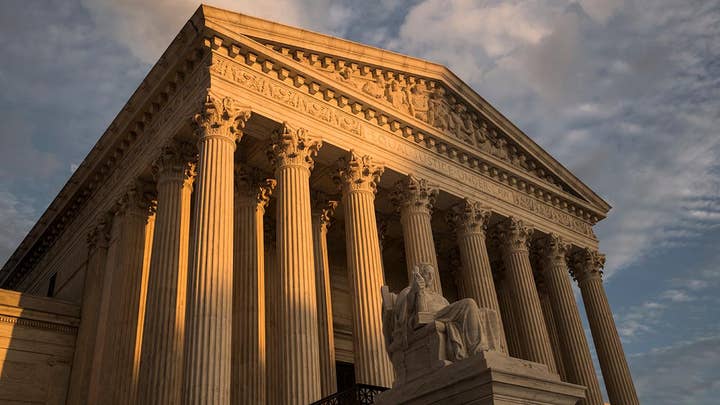Fox News Flash top headlines for June 5
Fox News Flash top headlines for June 5 are here. Check out what's clicking on Foxnews.com
Last week, the Supreme Court upheld an Indiana law requiring that fetal remains be treated as human remains – a victory for life and a substantial step toward recognizing the human dignity of the unborn. Yet it is the second issue in the case – Indiana’s ban on abortions motivated solely by the fetus’s race, sex, or disability – that has drawn the most public attention. The Supreme Court deferred addressing the permissibility of such laws until more courts around the country have considered the issue.
In an interview, the day after the ruling, CNN’s Alisyn Camerota asked a provocative question: “Why would you want a family to have to have a child with a severe disability?” She went on to cite the examples of Trisomy 13 and Trisomy 18: “That child will have so many problems and will most likely not live past their first birthday. Why would lawmakers force parents to bring that child to fruition?”
Such questions remind me of one of my favorite literary characters, Charles Dickens' Ebenezer Scrooge from "A Christmas Carol." Speaking of those who, like Tiny Tim, have disabilities that leave them poor and destitute, Scrooge says, “But if he is to die, then let him die and decrease the surplus population.” In response, the Ghost of Christmas Present uses Scrooge’s own words against him: “Will you choose what men shall live and what men shall die? It may be that in the sight of Heaven your life is worth less than millions like this poor man’s child.”
Dickens’s story is a testament to his time, but how far have we really come since the novel was published in 1843? Justice Clarence Thomas, in his concurring opinion in the Indiana case, provided an answer: not far.
Justice Thomas offered a compelling 20-page analysis detailing the historical link between abortion and the progressive movement’s goal of creating a more desirable human population.
Planned Parenthood founder Margaret Sanger, a prominent advocate of eugenics, wrote in 1921 that “the most urgent problem today is how to limit and discourage the over-fertility of the mentally and physically defective.” Sanger advocated for birth-control policies (including sterilization) designed to limit births among “the inferior classes.”
Sanger’s views propelled the mission of the organization she started.
“Even after World War II,” Justice Thomas wrote, “future Planned Parenthood President Alan Guttmacher and other abortion advocates endorsed abortion for eugenic reasons and promoted it as a means of controlling the population and improving its quality.”
There is no escaping the hard truth that permitting abortion of the disabled not only denies equal human worth but also gradually eliminates the disabled from society. Iceland has reached a nearly 100 percent elimination rate for babies with Down syndrome, and the United States and other developed countries are not far behind.
Seven decades later, science is delivering the promise of abortion as a eugenic tool. “With today’s prenatal screening tests and other technologies, abortion can easily be used to eliminate children with unwanted characteristics,” Thomas wrote.
In the Supreme Court, Planned Parenthood actually argued that permitting parents to abort babies with, say, Down syndrome creates net social benefits by ensuring that those not aborted grow up in homes where they are wanted and supported. Too bad, I guess, for the babies that must die to achieve that socially optimal result.
And to answer Camerota: Science affords us many wondrous tools, but science is not ethics, and because all human beings have equal dignity and worth, parents should not kill their disabled children in the womb.
There is no escaping the hard truth that permitting abortion of the disabled not only denies equal human worth but also gradually eliminates the disabled from society. Iceland has reached a nearly 100 percent elimination rate for babies with Down syndrome, and the United States and other developed countries are not far behind.
How did we get here? To paraphrase Dickens, it is a chain we forged for ourselves – link by link and yard by yard. Since the Supreme Court’s decision in Roe in 1973, we have “progressed” from the “safe, legal, and rare” abortion-as-a-necessary-evil argument to the “shout your abortion” campaign glorifying abortion as a positive good.
The idol of choice has become the god to whom we have sacrificed not only the dignity of human life but also the equality that our nation fought so hard to achieve.
CLICK HERE TO GET THE FOX NEWS APP
“Given the potential for abortion to become a tool of eugenic manipulation,” Justice Thomas wrote, “the Court will soon need to confront the constitutionality of laws like Indiana’s.”
Sadly, Indiana was once a eugenics leader, passing the first sterilization law in 1907. Now, even as we wait for the Supreme Court to allow bans on abortion as a eugenic tool, Indiana will redeem that dark history and stand strong for a culture of life.


